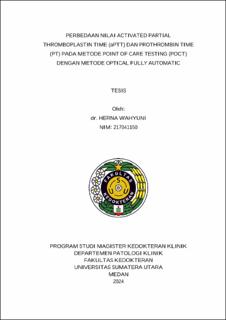| dc.contributor.advisor | Siregar, Dewi Indah Sari | |
| dc.contributor.advisor | Permatasari, Ranti | |
| dc.contributor.author | Wahyuni, Herna | |
| dc.date.accessioned | 2025-10-15T02:05:12Z | |
| dc.date.available | 2025-10-15T02:05:12Z | |
| dc.date.issued | 2024 | |
| dc.identifier.uri | https://repositori.usu.ac.id/handle/123456789/109474 | |
| dc.description.abstract | Objective : To determine the difference in Activated Partial Thromboplastin Time (aPTT) and Prothrombin Time (PT) values between point-of-care testing (POCT) and optical fully automatic methods.
Method : This study used a cross-sectional design with non-probability sampling of 100 patients treated at Adam Malik Hospital from July to September 2024. Each citrate sample was tested for aPTT and PT parameters using the POCT method and the optical fully automatic method. This study also tested the precision of both methods. Data were analyzed using the Mann–Whitney test, Bland-Altman Plot, and correlation test. Data were analyzed statistically using SPSS, and results were considered significant if p<0.05.
Results : There was a significant difference (p < 0.001) in the results of the comparison test of aPTT and PT values between the POCT method and the optical fully automatic method, with the median aPTT and PT values in the POCT method being higher than those in the optical fully automatic method. The Bland- Altman Plot test showed that many points were outside the limit of agreement, indicating that the difference between the two measurement methods was quite significant. The correlation test showed a significant strong positive correlation between the POCT method and the optical fully automatic method (aPTT: r = 0.728 p<0.001 and PT r= 0.886 p<0.001). The average difference between the two methods was 6.6 seconds for the aPTT parameter and 4.98 seconds for the PT parameter. The precision test of the POCT method found CV%: aPTT 1.48% and PT 3.18%, while the optical fully automatic method found a higher CV%: aPTT: 2.13% and PT 7.05%.
Conclusion : There is a significant difference in aPTT and PT values between the POCT method and the optical fully automatic method. Precision tests on the POCT method show good results. | en_US |
| dc.language.iso | id | en_US |
| dc.publisher | Universitas Sumatera Utara | en_US |
| dc.subject | aPTT | en_US |
| dc.subject | optical fully automatic | en_US |
| dc.subject | POCT | en_US |
| dc.subject | PT | en_US |
| dc.title | Perbedaan Nilai Activated Partial Thromboplastin Time (aPTT) Dan Prothrombin Time (PT) Pada Metode Point Of Care Testing (POCT) Dengan Metode Optical Fully Automatic | en_US |
| dc.title.alternative | Differences in Activated Partial Thromboplastin Time (aPTT) and Prothrombin Time (PT) Values on Point of Care Testing (POCT) Methods with Fully Automated Optical Methods | en_US |
| dc.type | Thesis | en_US |
| dc.identifier.nim | NIM217041150 | |
| dc.identifier.nidn | NIDN0021098301 | |
| dc.identifier.nidn | NIDN0010018402 | |
| dc.identifier.kodeprodi | KODEPRODI11103#Ilmu Kedokteran Klinis | |
| dc.description.pages | 103 Pages | en_US |
| dc.description.type | Tesis Magister | en_US |
| dc.subject.sdgs | SDGs 3. Good Health And Well Being | en_US |


